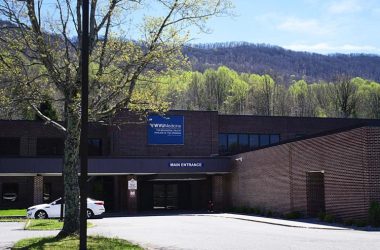By RICK STEELHAMMER
Charleston Gazette-Mail
CHARLESTON, W.Va. — Plans to develop a new commercial rafting option on the 5.3-mile section of the New River between Hawks Nest Dam and Gauley Bridge known as the “Dries” are still afloat, but not at the level sought by state whitewater outfitters.

(Gazette file photo)
Delays follow new flow and access requirements in a state Department of Environmental Protection water quality certificate for relicensing the dam.
The new flow management prescription for the last stretch of the New River before it merges with the Gauley at Gauley Bridge to form the Kanawha River calls for seven planned releases of water annually to accommodate whitewater rafting and recreational paddling.
The six-hour releases at 2,200 to 2,500 cubic feet per second would take place during the last weekend in June, the first two weekends in July and July 4, starting in 2019.
Outfitters hoped for about four times as many scheduled release dates.
Hawks Nest Dam, completed in 1933, diverts most of the New River’s flow through a 3.8-mile-long tunnel, in which at least 476 workers received lethal exposures to rock dust during its construction. Water channeled through the tunnel drops 162 feet during its trip to Gauley Bridge, where it powers turbines that supply electricity to the West Virginia Manufacturing silicon metal plant in Alloy.
The Dries gets its name from the river channel from which the water is diverted. During the summer and fall, water often flows at a trickle, relying on the required 100 cubic feet per second minimum releases from the dam to keep fish and other aquatic life alive during dry weather.
Despite its name, the Dries can get spectacularly wet following periods of heavy rain in its watershed, which includes parts of North Carolina, Virginia and West Virginia, drawing kayakers from across the region who respond immediately to reports that the Dries are runnable.
When the tunnel’s 10,000-cubic-feet-per-second maximum intake is exceeded, water passes through a gate in the dam creating flows as high as 90,000 cfs into the Dries. But high water spikes on the Dries are sporadic and vary widely in volume, making it impossible to schedule commercial raft trips on the sparsely traveled last leg of the New without special releases.
Outfitters and recreational paddlers began working with regulators nearly five years ago to look into scheduling whitewater releases in the Dries as part of the Federal Energy Regulatory Commission’s reauthorization process for licensing Hawks Nest Dam.
Two years ago, outfitters and paddlers took part in an FERC-sponsored study to determine the optimum flow levels to accommodate recreational boating and commercial rafting through the Dries.
Among them were members of American Whitewater, a national nonprofit organization representing more than 100 local paddling club affiliates across the country. They proposed to the FERC that 41 whitewater releases be scheduled annually from Hawks Nest Dam, while maintaining a 1,600-cfs flow through Hawks Nest Tunnel needed to operate the Alloy plant.
Only about 25 of the 41 release dates were expected to take place on average due to fluctuating flow conditions that make it impossible at times to feed 1,600 cfs into the turbines powering West Virginia Manufacturing’s operations while wetting the Dries with an additional 2,200 cfs.
The FERC initially proposed scheduling only three whitewater releases from the dam to take place during Memorial Day weekend, but it has been reviewing an alternative plan calling for 15 scheduled releases in the 2,200 to 2,500 cfs range.
While the FERC’s relicensing review for Hawks Nest dam is not complete, the agency has a history of accommodating recommendations from state regulators, and outfitters said they believe the DEP’s seven-day whitewater release plan will likely be adopted barring appeal.
In a January filing with the FERC, West Virginia Manufacturing said while releases of 1,600 cfs meets its minimum needs, the Alloy plant operates at less than peak efficiency when less than 3,200 cfs passes through the turbines. This forces the company to reduce furnace loads or switch furnaces, adding to its operating expenses.
On June 16, American Whitewater, a nonprofit organization representing thousands of individual whitewater paddlers and river conservationists, as well as members of more than 100 affiliated paddling clubs across the nation, filed an appeal with the DEP seeking to rescind, revise and reissue its water quality certificate for the dam’s relicensing.
“The state’s decision is a senseless and needless wasted opportunity to restore a great river,” wrote Kevin Colburn, American Whitewater’s national stewardship director, who filed the appeal.
Colburn said his organization’s plan for scheduling 41 release dates into the Dries — about 25 of which are expected to take place — better meets a DEP mandate “to seek the ultimate development of recreational resources consistent with primary project purposes.”
Colburn also objected to the DEP’s decision allowing Hawks Nest Power to leave gated and inaccessible a single-lane dirt road that follows a 1.2-mile segment of the Dries between the base of the dam and a parking area off W.Va. Route 16 near the Cotton Hill Bridge. That decision torpedoed plans to shuttle rafts and whitewater customers to a put-in point immediately below the dam and effectively reduced a 5.3-mile whitewater run on the Dries to 4.1 miles.
The DEP’s certificate requires Hawks Nest Hydropower to build an access trail for hikers and bikers from near the base of the tramway past the intake structure to the gated road extending from the base of the dam downstream to the bridge.
It also requires Hawks Nest Hydropower to provide $50,000 by June 2018 to improve a stream access site at the Division of Natural Resources’ Cotton Hill Day Use Area; build a changing facility, restrooms, picnic facilities, parking lot improvements and new signs the following year; build a new take-out area at Gauley Bridge by June 2019; and install a river gauge near Cotton Hill Bridge that posts real-time river flow and depth information online to keep recreational boaters and outfitters better apprised of river conditions.
To make the Dries more hospitable to aquatic life, the DEP water quality certificate requires Hawks Nest Hydropower to increase minimum flow through the Dries from the current 100 cfs to 300 cfs from March 1 to June 30, and to maintain a minimum flow of at least 250 cfs for the remainder of each year.
The DEP’s decision to require seven days of planned whitewater releases annually “gives us something, but it’s pretty disheartening in a lot of other ways,” said Bobby Bower, director of the West Virginia Professional River Outfitters and a fishing guide on the lower New.
Bower said he hoped to get 30 scheduled whitewater release dates on the Dries, which he said “would really get people to come here and run a new stretch of river, while giving the Upper Kanawha Valley’s economy a boost.”
Bower said he favored springtime whitewater releases when water flow is more abundant, making more releases possible. But a recommendation from the DNR to delay the releases until spring spawning season ends in early June was honored in the DEP certificate.
“We already have huge fluctuations in stream flow during the spring spawning season,” Bower said. “Flow through the Dries can rapidly go from 300 to 60,000 cfs.”
Scheduled releases to accommodate recreational whitewater during the spring months would not likely have a significant effect on spawning, he said.
“People like new products, and in our industry we need to come up with new products to be able to survive,” Arnold said.
At flows of 2,200 to 2,500 cfs, the Dries would provide a family friendly series of Class II and III rapids in a three-hour trip through a scenic canyon, he said.
“There’s been a pretty steady campaign from one side that they can’t give up too much water and continue to operate their business, while the other sides argues that the Dries is a real river and it should be treated that way,” Arnold said. “I think the DEP worked really hard to come up with a compromise. We didn’t get everything we wanted — more days and more put-ins — but we got a new product we can sell that may get people to stay a day longer in the area.”
See more from the Charleston Gazette-Mail




